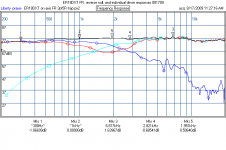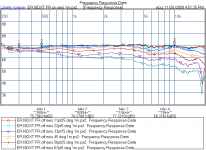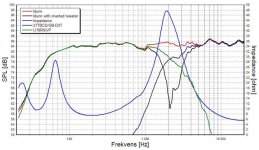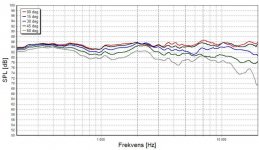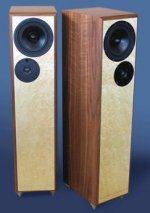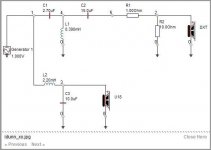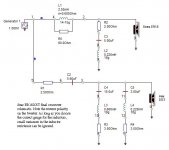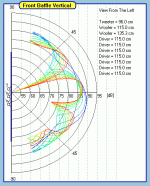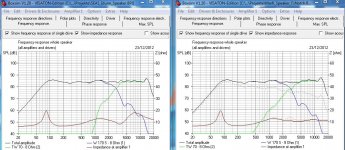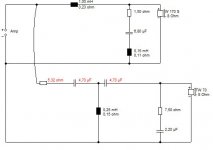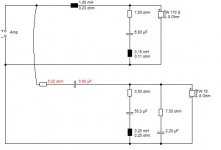Hi all,
I am a new member, about to retire though.
I have built several loudspeakers published in a Finnish Hifi-magazine. Some of them have become classic, especially the 85/3 which still sound excellent after 25 years in a 450 m3 loghouse driven by a 2x25W amp.
Now back to business: I have spent plenty of hous searching for suitable loudspeakers for my 19m2 livingroom having concrete walls. Seas Thor was one of the candidates but having read several sites it was rejected. Not only because of contradicting opinions but also because they were oversized for my needs.
Finally I ended up with a Murray Zeligman design, the Idunn, which seems to satisfy my needs. Not least because of the sound quality but also because of the box redesingn of a Finnish HiFi company.
The boxes were built by a young friend in the vocational school. He did an excellent job! I also changed the boxes for two tubes in order to be able to adjust them for the room acoustics.
My main worry is that the baffle widht is less than in the original plans. The woofer is also placed on the top of the box which also is different from the original. Now I am wondering how these changes are affecting the sound quality and what changes should be eventually done to the crossover.
I am going to cover the inner sidewalls with adhesive bitumen sheets and add 250g polyester wool into the two upper compartments to start with. The backplate is fastened with M4 bolts to enable easy changes and experiments.
I'll finish now wondering if I can add some pictures. Typical newbie problem
Well, it seems that I am in trouble now! Maybe next time.
Jouko
I am a new member, about to retire though.
I have built several loudspeakers published in a Finnish Hifi-magazine. Some of them have become classic, especially the 85/3 which still sound excellent after 25 years in a 450 m3 loghouse driven by a 2x25W amp.
Now back to business: I have spent plenty of hous searching for suitable loudspeakers for my 19m2 livingroom having concrete walls. Seas Thor was one of the candidates but having read several sites it was rejected. Not only because of contradicting opinions but also because they were oversized for my needs.
Finally I ended up with a Murray Zeligman design, the Idunn, which seems to satisfy my needs. Not least because of the sound quality but also because of the box redesingn of a Finnish HiFi company.
The boxes were built by a young friend in the vocational school. He did an excellent job! I also changed the boxes for two tubes in order to be able to adjust them for the room acoustics.
My main worry is that the baffle widht is less than in the original plans. The woofer is also placed on the top of the box which also is different from the original. Now I am wondering how these changes are affecting the sound quality and what changes should be eventually done to the crossover.
I am going to cover the inner sidewalls with adhesive bitumen sheets and add 250g polyester wool into the two upper compartments to start with. The backplate is fastened with M4 bolts to enable easy changes and experiments.
I'll finish now wondering if I can add some pictures. Typical newbie problem

Well, it seems that I am in trouble now! Maybe next time.

Jouko
Hi jouko, welcome aboard! 
SEAS IDUNN kit:
Idunn
Very interesting speaker. Advanced U18RNX/P polycone H1571-08 U18RNX/P and DXT tweeter H1499-06 27TBCD/GB-DXT.
Will follow this with interest. TBH, wouldn't think small baffle width changes or turning the drivers upside down would make a huge difference, but you are in best position to judge the sound. The DXT tweeter is an odd thing though. I do always wonder if some more regular tweeter would make more sense as in the SEAS CURV design.
SEAS CURV
SEAS IDUNN kit:
Idunn
Very interesting speaker. Advanced U18RNX/P polycone H1571-08 U18RNX/P and DXT tweeter H1499-06 27TBCD/GB-DXT.
Will follow this with interest. TBH, wouldn't think small baffle width changes or turning the drivers upside down would make a huge difference, but you are in best position to judge the sound. The DXT tweeter is an odd thing though. I do always wonder if some more regular tweeter would make more sense as in the SEAS CURV design.
SEAS CURV
Hello ,
and many thanks for your comments.
You made an interesting question concerning the tweeter choice. 0 Having read the article in the Audio Beat written by Allen Edelstein I became ever more convinced about the skills of Murray Zeligmann. The Audio Beat - SEAS Idunn Loudspeaker Kit. If I understood him right the W ad T have about the same dispersion at the crossover frequency which helps to hide the transmission. The T also has a wide dispersion at higher frequencies which widens the off-axis response at higher frequensies. I am pretty much for this type of tweeter design, not least because my old speakers (HiFi 12/2 designed by a Finnish "guru" Pekka Tuomela) are using Dynaudio D-28 tweeters and I really never felt like sensing the crossover transfer. D-28 has a clean convex while the 27TBCD/GB-DXT has a proportional reflector just like the well known Vifa D25TG-55-06.I will hopefully have the starting version ready in two weeks time, the burn-in will be at least a 100 hrs. I'll be back then at the latest.
Maybe you can help me out of the problem attaching photos. I understand that I need to open (an) internet page(s) and link them as in many sites. Copying from my computer did'nt work.
In the meantime I wish you a peaceful xmas time. We have here temperature of -12C plus wind factor and there is 35cm snow on the ground. The organic ham will soon enter the owen for a 8-12 hrs sauna session at 80C.
Best regards,
Jouko, Helsinki Finland
and many thanks for your comments.
You made an interesting question concerning the tweeter choice. 0 Having read the article in the Audio Beat written by Allen Edelstein I became ever more convinced about the skills of Murray Zeligmann. The Audio Beat - SEAS Idunn Loudspeaker Kit. If I understood him right the W ad T have about the same dispersion at the crossover frequency which helps to hide the transmission. The T also has a wide dispersion at higher frequencies which widens the off-axis response at higher frequensies. I am pretty much for this type of tweeter design, not least because my old speakers (HiFi 12/2 designed by a Finnish "guru" Pekka Tuomela) are using Dynaudio D-28 tweeters and I really never felt like sensing the crossover transfer. D-28 has a clean convex while the 27TBCD/GB-DXT has a proportional reflector just like the well known Vifa D25TG-55-06.I will hopefully have the starting version ready in two weeks time, the burn-in will be at least a 100 hrs. I'll be back then at the latest.
Maybe you can help me out of the problem attaching photos. I understand that I need to open (an) internet page(s) and link them as in many sites. Copying from my computer did'nt work.
In the meantime I wish you a peaceful xmas time. We have here temperature of -12C plus wind factor and there is 35cm snow on the ground. The organic ham will soon enter the owen for a 8-12 hrs sauna session at 80C.
Best regards,
Jouko, Helsinki Finland
Hi,
The x/o is designed for a listening axis on axis with the tweeter. This means
vertical dispersion will not be symmetrical and worse with the drivers inverted.
The BSC of a driver mounted in about the middle of a tall box will change
somewhat if its mounted at either extreme (open stands for the bottom).
Baffle width will make a minor difference, it cant be much smaller.
rgds, sreten.
Nothing wrong with the principles of the DXT tweeter, the
distortion (which is better) or controlled dispersion wise.
The x/o is designed for a listening axis on axis with the tweeter. This means
vertical dispersion will not be symmetrical and worse with the drivers inverted.
The BSC of a driver mounted in about the middle of a tall box will change
somewhat if its mounted at either extreme (open stands for the bottom).
Baffle width will make a minor difference, it cant be much smaller.
rgds, sreten.
Nothing wrong with the principles of the DXT tweeter, the
distortion (which is better) or controlled dispersion wise.
Last edited:
Hello streten and thanks for your comments.
I am sorry but I cannot understand what you mean. If the loudspeakers are placed inversely they are still on the same vertical axis from the x/o point of wiev. I don't believe that gravity would play any role here.
Best regards,
Jouko
I am sorry but I cannot understand what you mean. If the loudspeakers are placed inversely they are still on the same vertical axis from the x/o point of wiev. I don't believe that gravity would play any role here.
Best regards,
Jouko
Hei Jouko,
sreten is trying to explain the concept of "design axis" which is practically never 90¤ to the front plane. Usually this axis is at tweeter level measured 1 or 2m from the speaker. If you increase distance, the optimal listening/measuring level is higher and vice versa (supposing the tweeter is above the woofer). How and how easily the effect of this is heard depends on many factors.
One issue of Idunn is the booming of 2 kHz area despite of the claims of not happening. Check the attached graphs of Idunn and MarkK's ER18DXT, which is better (different scale). ER has 2nd order xo instead of 4th of Idunn - thus the tweeter plays earlier in frequencies.
The graphs are copied from these original pages
Idunn
The Seas ER18DXT ported two way
You can attach files from your computer by pressing "Go Advanced" - first Select files then press Upload
Hyvää Joulua!
Juha
sreten is trying to explain the concept of "design axis" which is practically never 90¤ to the front plane. Usually this axis is at tweeter level measured 1 or 2m from the speaker. If you increase distance, the optimal listening/measuring level is higher and vice versa (supposing the tweeter is above the woofer). How and how easily the effect of this is heard depends on many factors.
One issue of Idunn is the booming of 2 kHz area despite of the claims of not happening. Check the attached graphs of Idunn and MarkK's ER18DXT, which is better (different scale). ER has 2nd order xo instead of 4th of Idunn - thus the tweeter plays earlier in frequencies.
The graphs are copied from these original pages
Idunn
The Seas ER18DXT ported two way
You can attach files from your computer by pressing "Go Advanced" - first Select files then press Upload
Hyvää Joulua!
Juha
Attachments
Last edited:
Hello streten and thanks for your comments.
I am sorry but I cannot understand what you mean. If the loudspeakers are placed
inversely they are still on the same vertical axis from the x/o point of wiev.
I don't believe that gravity would play any role here.
Best regards,
Jouko
Hi,
The x/o optimum axis is tilted up so the optimum axis is the tweeter
axis. Inverting the drivers tilts it down, nothing to do with gravity.
If your tweeters are still at ear height its not much of a problem,
but typically for inverted ear height becomes the bass/mid axis.
Inverted with bass/mid at ear height would be a different x/o.
rgds, sreten.
I can see this turning into the usual confusion already. 
I don't think MarkK's SEAS Reed Cone + DXT design has much relevance here beyond some vague claims of being better than the Polycone Idunn on horizontal dispersion... I thought his filter was good on the Reed bass, but quite wrong on the innaccurate Fs tweeter notch. In any event the Fs notch makes it 4th order acoustic just like the Idunn.
Robin Marshall discusses dispersion at crossover:
Inverted speakers have a splendid history, as illustrated by John DeVore's interesting Gibbon8 speaker. Let's see how it goes.
I don't think MarkK's SEAS Reed Cone + DXT design has much relevance here beyond some vague claims of being better than the Polycone Idunn on horizontal dispersion... I thought his filter was good on the Reed bass, but quite wrong on the innaccurate Fs tweeter notch. In any event the Fs notch makes it 4th order acoustic just like the Idunn.
Robin Marshall discusses dispersion at crossover:
Robin Marshall: A Modicum of Genius | Stereophile.comMarshall: I don't believe at all in the "let's get rid of the drive-unit as quickly as we possibly can" approach. Because if you're crossing over from a large unit into a small one, you've got a radiation pattern change straightaway. If you get this business where they're both rolling off extremely steeply so you've got a very fast change between two quite different polar patterns, that's very noticeable. The coloration generated by the off-axis performance of the speaker is going to be very noticeable. On-axis, it may measure as flat as a pancake; in theory, if you could listen to the speaker in an anechoic chamber, it might sound great. But once you put it into a real live room it's going to sound awful.
Inverted speakers have a splendid history, as illustrated by John DeVore's interesting Gibbon8 speaker. Let's see how it goes.
Attachments
Hei Juha,
thank you for your informative remarks. I am still in the process of learning the
theory and terms of loudspeaker design Being retired I have more time but the transformation from a legal background to acoustics and related electronics will take some time.
Being retired I have more time but the transformation from a legal background to acoustics and related electronics will take some time.
I fully agree with the 2Khz boost based on the graphs and it is even more visible on the woofer graph of the manufacturer. I need to listen first and then come back to find out if there are ways to filter it out without spoiling the good sides of the consept. Again, looking at the graphs it paradoxically seems that the Idunn should sound best from a 30 degrees angle which the tweeter is able to handle pretty well.
Would be fruitful from my side to talk you more frequently in the future.
In the meantime I wish you hyvää joulua aswell.
Best regards,
Jouko
thank you for your informative remarks. I am still in the process of learning the
theory and terms of loudspeaker design
I fully agree with the 2Khz boost based on the graphs and it is even more visible on the woofer graph of the manufacturer. I need to listen first and then come back to find out if there are ways to filter it out without spoiling the good sides of the consept. Again, looking at the graphs it paradoxically seems that the Idunn should sound best from a 30 degrees angle which the tweeter is able to handle pretty well.
Would be fruitful from my side to talk you more frequently in the future.
In the meantime I wish you hyvää joulua aswell.
Best regards,
Jouko
Hello tvrgeek and thanks for the comment. Your conclusion is a piece of philosophy. I will try to keep it in mind and trust my ears in the first place.
I promise to measure whenever problems arise. So far I don't feel like being burned but I'll be careful.
Have a merry xmas.
Best regards,
Jouko
I promise to measure whenever problems arise. So far I don't feel like being burned but I'll be careful.
Have a merry xmas.
Best regards,
Jouko
Hi,
Nothing against inverted driver speakers, except the seriously very crappy
Wharfedales, which I'm proud of not being able to remember the model of.
The classic budget model being of course the Mission 700's :
The x/o doesn't work half as well the other way up.
rgds, sreten.
Nothing against inverted driver speakers, except the seriously very crappy
Wharfedales, which I'm proud of not being able to remember the model of.
The classic budget model being of course the Mission 700's :
An externally hosted image should be here but it was not working when we last tested it.
The x/o doesn't work half as well the other way up.
rgds, sreten.
Last edited:
BTW, Jouko, I had a look at crossover issues with inverted drivers here:
http://www.diyaudio.com/forums/multi-way/225874-logic-behind-focal-diablo-utopias-slanted-speaker-design-compared-flat-5.html#post3291712
A 2.2 kHz crossover is a slightly different animal due to the longer wavelength at crossover, but tweeter phase inversion is still worth trying.
http://www.diyaudio.com/forums/multi-way/225874-logic-behind-focal-diablo-utopias-slanted-speaker-design-compared-flat-5.html#post3291712
A 2.2 kHz crossover is a slightly different animal due to the longer wavelength at crossover, but tweeter phase inversion is still worth trying.
Guys,
I sort of cut the corners in my previous messages
I'm not expert enoght to desing speakers but this is what I have read:
The design axis is what the designer decides to use when he is measuring the spakers and he/she tries to make this on-axis measurement as good as possible. The position of mid and tweeter drivers( vertically and horizontally), the proportions of the baffle and the type of xo contribute to radiation pattern and directivity.
Typically a 2-way with 2nd order LR xo, the polar radiation tends to be tilted to the woofer's side. This is why many speakers utilizing this concept have the tweeter below. Like Mission above and many speakers of Harri Huuhkaja
The DXT has it's voice coil and membrane (the acoustic center) a little more back than conventional tweeters, and that makes it easier to make a LR2 xo with a tweeter above the midwoofer. John Krutke tells obout this in his TMM page Zaph|Audio
And finally here is Stereophile Magazine's story on measuring dispersion Measuring Loudspeakers, Part Three Page 7 | Stereophile.com
Jouko, I live in Jyväskylä but you can email me juha.sirkka(miukumauku)fimnet.fi
System7, thank you for your wise and nice writings here at diyaudio.com!
Merry Christmas to all of you!
Juha
I sort of cut the corners in my previous messages
I'm not expert enoght to desing speakers but this is what I have read:
The design axis is what the designer decides to use when he is measuring the spakers and he/she tries to make this on-axis measurement as good as possible. The position of mid and tweeter drivers( vertically and horizontally), the proportions of the baffle and the type of xo contribute to radiation pattern and directivity.
Typically a 2-way with 2nd order LR xo, the polar radiation tends to be tilted to the woofer's side. This is why many speakers utilizing this concept have the tweeter below. Like Mission above and many speakers of Harri Huuhkaja
The DXT has it's voice coil and membrane (the acoustic center) a little more back than conventional tweeters, and that makes it easier to make a LR2 xo with a tweeter above the midwoofer. John Krutke tells obout this in his TMM page Zaph|Audio
And finally here is Stereophile Magazine's story on measuring dispersion Measuring Loudspeakers, Part Three Page 7 | Stereophile.com
Jouko, I live in Jyväskylä but you can email me juha.sirkka(miukumauku)fimnet.fi
System7, thank you for your wise and nice writings here at diyaudio.com!
Merry Christmas to all of you!
Juha
Last edited:
And here is Zaph's graph of vertical polar pattern that I wanted to show
System7, can you please specify the ER18DXT tweeter notch problem?. Mark says that he used the two notch circuits to achieve acoustic 2nd LR. XO is electric 1st order an drivers' own roll-off makes acoustic 2nd LR.
By the way I made Zaph's LR18 first but was not happy. Then I used that box and converted it to ER18DXT and now I'm happy (avatar pic). Zaph himself has said that MarkK's speaker is an upgrade to his SR71 which uses the same reed cone midwoofer. The L18 has conventional LR4 xo and a quite bad horizontal dispersion by today's standards.
Also I'd like to thank You sreten for your wise and nice writings here at diyaudio.com!
Juha
System7, can you please specify the ER18DXT tweeter notch problem?. Mark says that he used the two notch circuits to achieve acoustic 2nd LR. XO is electric 1st order an drivers' own roll-off makes acoustic 2nd LR.
By the way I made Zaph's LR18 first but was not happy. Then I used that box and converted it to ER18DXT and now I'm happy (avatar pic). Zaph himself has said that MarkK's speaker is an upgrade to his SR71 which uses the same reed cone midwoofer. The L18 has conventional LR4 xo and a quite bad horizontal dispersion by today's standards.
Also I'd like to thank You sreten for your wise and nice writings here at diyaudio.com!
Juha
Attachments
Last edited:
Juhazi, you are hijacking the thread with too much discussion of MarkK's ER18DXT project. 
FWIW, MarkK and I had a heated and interesting discussion of the supposed advantages of his "First Order" DXT tweeter filter here:
http://www.diyaudio.com/forums/multi-way/220694-erse-inductors-europe-3.html#post3185582
In practise it turns out to model almost identically to the much simpler third order DXT tweeter crossover in the SEAS Idunn. That is when it is accurately and properly executed, which his IS NOT!
His filter and speaker is goodish overall, but not for the reasons he thinks. Too much Snake Oil in this game. It doesn't make me popular to point this sort of stuff out, but someone's got to do it.
FWIW, MarkK and I had a heated and interesting discussion of the supposed advantages of his "First Order" DXT tweeter filter here:
http://www.diyaudio.com/forums/multi-way/220694-erse-inductors-europe-3.html#post3185582
In practise it turns out to model almost identically to the much simpler third order DXT tweeter crossover in the SEAS Idunn. That is when it is accurately and properly executed, which his IS NOT!
His filter and speaker is goodish overall, but not for the reasons he thinks. Too much Snake Oil in this game. It doesn't make me popular to point this sort of stuff out, but someone's got to do it.
Attachments
Typically a 2-way with 2nd order LR xo, the polar
radiation tends to be tilted to the woofer's side.
Juha
Hi,
Not if you make the output purposely slightly assymetric
for both LR2 and LR4 acoustic to tilt the optimum axis.
Here is an example of assymetry to fix path length differences :
My RS180 MTM Design
Note the perfect phase wrap at the x/o point.
rgds, sreten.
- Status
- This old topic is closed. If you want to reopen this topic, contact a moderator using the "Report Post" button.
- Home
- Loudspeakers
- Multi-Way
- Seas Idunn revisited-project
